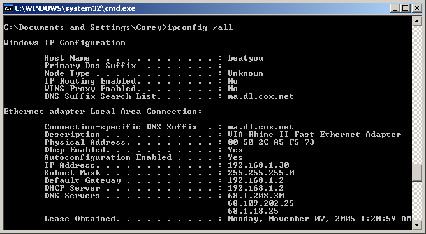 | ||
In computing, ipconfig (internet protocol configuration) in Microsoft Windows is a console application that displays all current TCP/IP network configuration values and can modify Dynamic Host Configuration Protocol (DHCP) and Domain Name System (DNS) settings.
Contents
In most cases, the ipconfig command is used with the command-line switch /all. This results in more detailed information than ipconfig alone.
Forced release and renew
An important additional feature of ipconfig is to force refreshing of the DHCP IP address of the host computer to request a different IP address. This is done using two commands in sequence. First, ipconfig /release is executed to force the client to immediately give up its lease by sending the server a DHCP release notification which updates the server's status information and marks the old client's IP address as "available". Then, the command ipconfig /renew is executed to request a new IP address. Where a computer is connected to a cable or DSL modem, it may have to be plugged directly into the modem network port to bypass the router, before using ipconfig /release and turning off the power for a period of time, to ensure that the old IP address is taken by another computer.
The /flushdns parameter can be used to clear the Domain Name System (DNS) cache to ensure future requests use fresh DNS information by forcing hostnames to be resolved again from scratch.
Mac OS X ipconfig
ipconfig in Mac OS X serves as a wrapper to the IPConfiguration agent, and can be used to control the BootP and DHCP client from the command-line interface. Like most UNIX-based operating systems, Mac OS X also uses ifconfig for more direct control over network interfaces, such as configuring static IP addresses.
